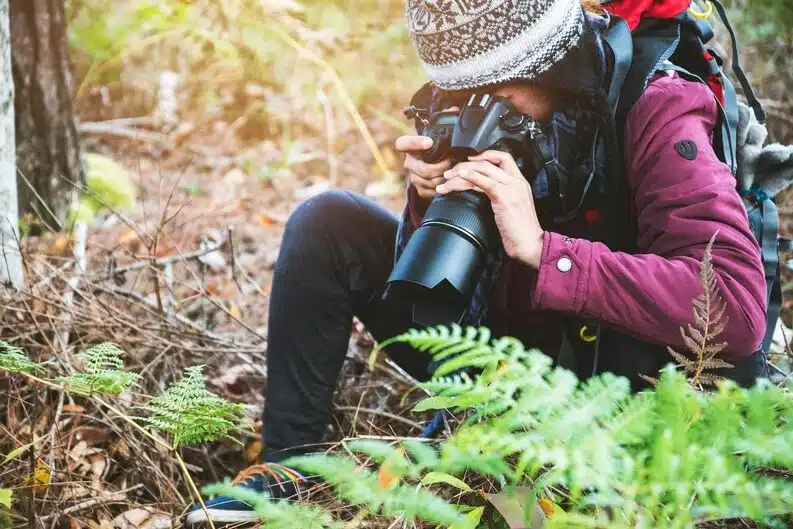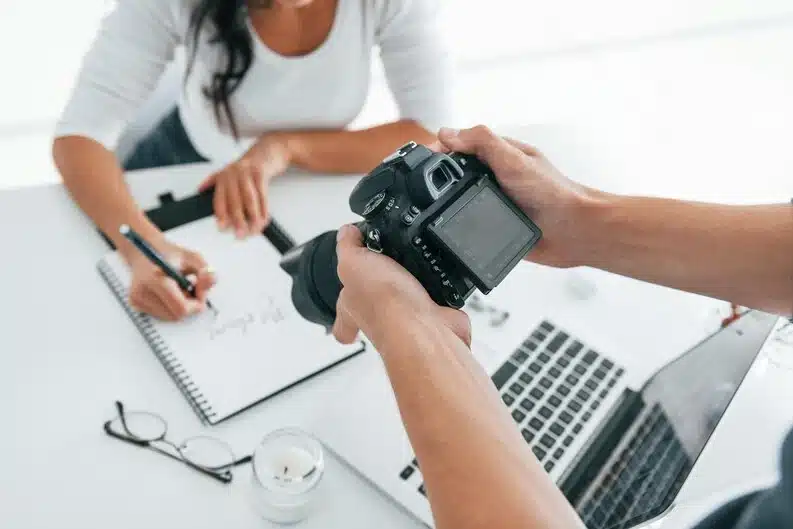Welcome, fellow photography enthusiasts and professionals! Are you worried about what might happen if your expensive camera takes a tumble during a session?
Or perhaps you’re concerned about potential liability issues when shooting at client locations? You’ve landed in exactly the right place.

This comprehensive guide to photographer insurance will walk you through everything you need to know to protect your passion, business, and equipment. Let me show you how to safeguard your photography career with the right insurance coverage.
Contents
- What Is Photographer Insurance and Why Do You Need It?
- Types of Photographer Insurance You Need
- Special Considerations for Different Types of Photography
- How to Choose the Right Insurance for Your Photography Business
- Smart Ways to Save on Photographer Insurance
- Short-Term Photographer Insurance
- FAQs About Photographer Insurance
- The Bottom Line: Insurance Is an Investment, Not an Expense
- Ready to Protect Your Photography Business?
What Is Photographer Insurance and Why Do You Need It?
Picture this: You’re shooting a wedding, carefully positioning yourself to capture that perfect moment when the bride walks down the aisle. Suddenly, a guest trips over your lighting stand, injuring themselves and damaging your expensive equipment. Without proper photographer insurance, this scenario could potentially end your business before it truly begins.
As someone who’s been in the photography industry for years, I’ve seen too many talented artists lose everything because they thought insurance was an unnecessary expense. The truth? Photographer insurance isn’t just a safety net—it’s the foundation that allows you to focus on creating beautiful images without constant worry.
The Real Cost of Going Uninsured
I remember a colleague who decided to skip insurance to save a few hundred dollars a year. During a corporate event, a client tripped over his camera bag and broke her ankle. The resulting lawsuit cost him over $45,000—far more than he would have paid for years of comprehensive insurance coverage.
Types of Photographer Insurance You Need
Different photography specialties require different types of protection. Whether you’re shooting weddings, commercial work, or family portraits, understanding the various insurance options available is crucial for comprehensive coverage.
General Liability Insurance:
General Liability Insurance protects you when accidents happen—and trust me, they will. This coverage is essential when clients or third parties experience bodily injury or property damage during your photography sessions.
Real-World Example: I was once photographing a family in their home when my light stand tipped over and damaged an antique mirror. My general liability insurance covered the $3,000 replacement cost, saving me from a significant out-of-pocket expense and preserving my relationship with the client.
This type of insurance typically covers:
- Bodily injury to clients or bystanders
- Property damage at shooting locations
- Legal defense costs if you’re sued
- Medical payments for injured parties
Professional Liability Insurance:
Also known as Errors & Omissions (E&O) Insurance, Professional Liability Insurance protects you when clients are unhappy with your work or claim you didn’t deliver as promised.
Imagine shooting a once-in-a-lifetime event, only to discover later that your memory card was corrupted and most images were lost. Professional liability insurance helps cover the costs associated with these types of scenarios, including legal defense and potential settlements.
Camera Equipment Insurance:
Let’s face it—photography equipment is expensive. A professional camera body, a few high-quality lenses, lighting equipment, and accessories can easily represent an investment of $10,000 or more. Camera Equipment Insurance ensures that your gear is protected against theft, damage, and loss.
There are two primary approaches to equipment insurance:
Scheduled vs. Unscheduled Equipment Insurance
| Feature | Scheduled Insurance | Unscheduled Insurance |
|---|---|---|
| Documentation | Requires a detailed list of each item and value | The simpler claims process with pre-documented items |
| Coverage Limits | Higher limits available for specific items | General limit for all equipment |
| New Purchases | Must update policy when acquiring new gear | Automatically covers new items up to certain limits |
| Premium Costs | Typically higher premiums | Usually lower premiums |
| Claim Process | Simpler claims process with pre-documented items | May require proof of ownership during claims |
| Best For | Photographers with expensive specialty gear | Photographers with standard equipment that changes frequently |
When I started my photography business, I opted for scheduled insurance since I had several high-value lenses that would have exceeded the limits of unscheduled coverage. As my business grew and I found myself regularly updating equipment, I switched to a combination approach—scheduling my most expensive items while keeping general coverage for accessories and smaller items.
Workers Compensation Insurance:
If you employ assistants, second shooters, or other staff, Worker’s Compensation Insurance isn’t just recommended—it’s often legally required. This insurance covers medical expenses and lost wages if your employees are injured while working for you.
I learned this lesson the hard way when my assistant slipped on wet grass during an outdoor wedding shoot. Without workers’ compensation, I would have been personally responsible for her medical bills and lost income during recovery.
Cyber Liability Insurance:
In today’s connected world, photographers store valuable client information and images digitally. Cyber Liability Insurance protects you from the fallout of data breaches or cyber-attacks that might compromise this sensitive information.
After a photographer friend had her client database hacked, exposing the addresses and payment information of hundreds of clients, I immediately added cyber liability coverage to my insurance portfolio. The peace of mind is worth every penny.
Special Considerations for Different Types of Photography
Wedding Photography Insurance
Wedding photographers face unique risks—high-pressure, one-time events with emotional clients and unpredictable environments. Comprehensive coverage should include:
- General and professional liability
- Equipment coverage
- Non-appearance insurance (in case you’re unable to shoot the event)
- Coverage for lost or damaged images
Commercial Photography Insurance
For commercial photographers working with businesses, additional considerations include:
- Higher liability limits (businesses typically sue for larger amounts)
- International coverage for overseas assignments
- Intellectual property protection
- Set and prop coverage
Travel Photography Insurance
If your photography takes you around the world, ensure your policies include:
- Worldwide equipment coverage
- International liability extensions
- Medical evacuation coverage
- Trip interruption insurance
How to Choose the Right Insurance for Your Photography Business

Selecting the right insurance coverage doesn’t have to be overwhelming. Here’s my step-by-step approach:
- Assess your specific risks: Consider your photography specialty, typical shooting locations, and whether you work with assistants.
- Evaluate your equipment: Create a comprehensive inventory of all your gear with purchase receipts and current replacement values.
- Research insurance providers: Look for companies specializing in photographer insurance who understand the unique needs of creative professionals.
- Compare quotes and coverage: Don’t just focus on premiums—pay close attention to coverage limits, deductibles, and exclusions.
- Check for venue requirements: Many venues require specific liability coverage before allowing you to shoot on their property.
Smart Ways to Save on Photographer Insurance
While cutting corners on insurance is never wise, there are legitimate ways to reduce costs:
- Bundle policies with the same provider for multi-policy discounts.
- Join professional organizations like Professional Photographers of America (PPA), which offer member insurance programs.
- Increase your deductibles if you have emergency savings to cover higher out-of-pocket costs when filing claims.
- Implement risk management practices like using proper equipment storage, security systems, and safe shooting techniques.
- Review and update your coverage annually to ensure you’re not paying for unnecessary protection.
Short-Term Photographer Insurance
Not every photographer needs year-round coverage. If you shoot infrequently or need coverage for specific events, Short-Term Photography Insurance provides flexibility and cost savings.
I’ve used event-specific insurance countless times for destination shoots or when working with high-profile clients who required increased coverage limits for their particular events.
FAQs About Photographer Insurance
What types of insurance do photographers need?
Photographers typically need General Liability Insurance, Professional Liability Insurance (Errors & Omissions), and Camera Equipment Insurance to protect against accidents, client dissatisfaction, and equipment damage. These insurances help cover legal fees, equipment replacement, and third-party injuries. Without them, photographers risk significant financial loss from unforeseen events.
How does General Liability Insurance protect photographers?
General Liability Insurance protects photographers from claims related to bodily injury or property damage during shoots. For example, if a client is injured at your studio, this insurance covers medical costs. It’s essential for safeguarding against third-party claims that could otherwise bankrupt your business.
What is Professional Liability Insurance for Photographers?
Professional Liability Insurance, also known as Errors & Omissions (E&O) Insurance, covers photographers against claims of unsatisfactory work, missed deadlines, or breach of contract. It helps manage disputes and preserves your professional reputation by covering legal defense and potential settlements when clients claim your work didn’t meet their expectations.
Is equipment covered worldwide?
Yes, if your equipment is insured on an equipment policy or scheduled on a Business Owner’s Policy, coverage is typically worldwide. This means your gear is protected even when traveling outside your home country, which is essential for travel photographers or those taking international assignments.
Can General Liability coverage be extended internationally?
Most General Liability policies cover lawsuits brought within the U.S., Canada, or Puerto Rico. However, coverage can be extended to other countries with additional endorsements and premiums. This is important for photographers working globally to ensure they’re protected regardless of where they shoot.
How does Worker’s Compensation Insurance apply to photographers?
Worker’s Compensation Insurance is necessary for photographers who employ staff, as it covers workplace injuries to employees. This insurance is crucial for protecting both the employer and employee in case of accidents during work and is often legally required once you hire your first assistant or employee.
What is the difference between scheduled and unscheduled equipment insurance?
Scheduled equipment insurance requires listing each item and its value for coverage, while unscheduled insurance covers equipment without needing a detailed list. Scheduled insurance often provides more comprehensive coverage but requires more administrative effort to maintain as your gear collection changes.
Can I get a Certificate of Insurance quickly?
Yes, many insurance providers offer quick issuance of Certificates of Insurance, often in minutes, which is useful for last-minute events or contracts. This allows photographers to quickly demonstrate their insurance status to clients or event organizers who require proof of coverage before allowing you to work at their venue.
How does Cyber Liability Insurance apply to photographers?
Cyber Liability Insurance protects photographers from data breaches or cyber attacks, which can compromise client data or intellectual property. This is increasingly important in the digital age, where photographers handle sensitive client information and store valuable images on connected devices or in the cloud.
Can I purchase short-term insurance for a single event?
Yes, many providers offer short-term or event-specific insurance policies, which are ideal for photographers covering one-off events. These policies provide flexibility and cost-effectiveness for occasional or short-term needs without committing to year-round coverage you might not need.
The Bottom Line: Insurance Is an Investment, Not an Expense
After a decade in the photography business, I’ve learned that proper insurance isn’t about compliance or checking boxes—it’s about creating a sustainable business that can weather unexpected challenges. The premiums you pay are an investment in your longevity as a photographer.
Remember: The best time to get insurance is before you need it. Tomorrow could bring an accident, a lawsuit, or equipment theft. Will you be prepared?
Ready to Protect Your Photography Business?
Don’t wait until disaster strikes. Start researching insurance options today, and consult with an insurance professional who specializes in creative businesses. Your photography career deserves the same care and protection you give to capturing perfect moments for your clients.
Have questions about your specific insurance needs? Share your thoughts in the comments below, or reach out to a professional insurance advisor who understands the unique requirements of photography businesses.